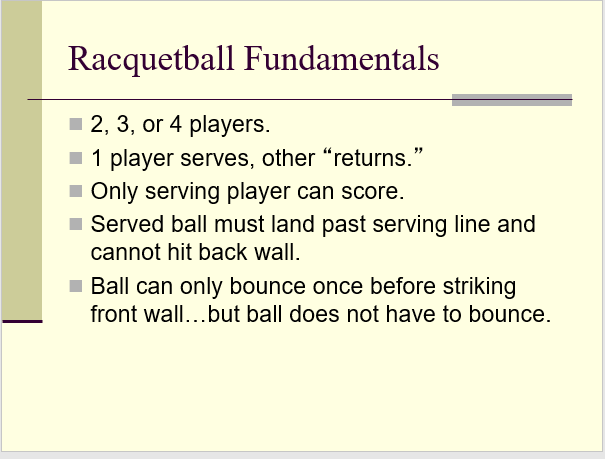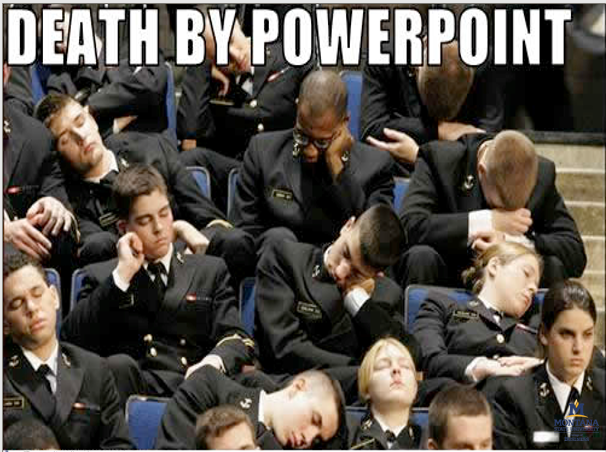William Shakespeare’s iconic phrase “To Be or Not to Be” from the play Hamlet seems fitting for today’s topic.
To PowerPoint or Not to PowerPoint – that is the question.
That most certainly is one of the top questions to ask when it comes to meetings.
Most people seem to choose the former when you consider that over 35 million PowerPoint presentations are given each day. It certainly seems based on my experience and others’ that PPT is the go-to for meeting prep.
But Amazon founder and CEO Jeff Bezos says not so fast.
His company, in fact, is one of the few places where you won’t encounter a PowerPoint at all, probably because they’ve been banned for executive meetings at the company since way back in 2004.
In critiquing this popular tool, Bezos explains:
PowerPoint style presentations give permission to gloss over ideas, flatten out any sense of relative importance, and ignore the interconnectedness of ideas.
It’s easy to see why Bezos would say this when you consider that 79% of people agree that “most presentations are boring.”
To me, this statistic wasn’t surprising at all, especially after the frequent encounters with sub-par, even laughable, presentations like these:



(Okay, okay. I had to put that last image in there for a little good humor.)
Of course, as I explain in a previous article on building ERM presentations, being the presenter in situations like this can be even more frustrating, even demoralizing.
What does Jeff Bezos and his team at Amazon use for a communication tool in lieu of PowerPoint?
In a podcast interview with computer scientist Lex Fridman, the executive explains how meetings at the company use a six-page memo approach, which is analyzed even more in this article.
The memo provides a “well-structured, narrative text” of the topic, replacing PowerPoint presentations, which Bezos believes enable presenters to hide sloppy thinking and just ramble about inconsequential matters, wasting valuable time. For everyone to be prepared for the discussion at hand, the first 30 minutes of any meeting are spent silently reading, focused on the prime reason why they are there.
The trigger for this starting style? Bezos said people were not preparing in advance for meetings.
We all know about that – rushing from one meeting into the next, no time to read any background materials in advance, and covering up the lack of preparation, all the while hoping the group discussion will result in a good decision.
On the other hand, the memo approach requires the presenter to think deliberately about what they need to say and how they need to say it. The memo delivers the author’s or presenter’s best thinking up-front, and when coupled with time for the audience to process that thinking, allows discussions to start much farther along than they would otherwise.
Personally, I find these benefits to be very appealing features of the memo/narrative approach as it facilitates, better thinking, a more robust discussion and decision-making process.
Another benefit of the memo is space…space to think, space to explain, space to tell the truth…for the creator. It also gives the reader space to think critically, take notes, get clarity in their own minds on the topic at hand.
Writing a memo promotes deeper and more complex thinking regarding the actual message the presenter is trying to convey. It also ensures that the writer thoroughly understands the topic at hand and will be able to meaningfully contribute to the meeting discussion.
(This six-page memo written on a non-Amazon topic by a former Amazon employee provides the layout and visual example of what it should look like when finished.)
Should you ditch PowerPoint for another communication tool like the six-page memo?
As with anything, there are cons to Bezos’ approach. Writing such a memo takes time (a commodity that many of us are short on frequently), focus, and a willingness to dig into the details. When it is difficult to find a decent block of thinking time, you can struggle to get the memo written well and edited properly prior to the meeting.
To my somewhat surprise, reaction to the Amazon approach was mixed, even among my team of risk and strategy consultants. Some say PowerPoint is used more as a prompt or outline, helping keep the topic on track or get back on track in the (often inevitable) event someone goes down a rabbit hole.
Another sensible critique of the memo approach says it doesn’t account for diverse learning styles, which is definitely a fair comment. We all comprehend information or knowledge differently, which is why this person recommended a flexible approach to meeting preparation rather than the rigid mandate as practiced at Amazon.
But on the other hand, others said that sending out a document, hoping for feedback in advance of a meeting, is pointless. Having someone take the time to actually read and absorb the document, think about the contents, then write up a comprehensive email with questions, comments, and feedback simply takes up too much time. Dedicating time within the meeting to do all 3 elements plus come to a decision (and capture follow-up items) is a helpful tool to keep companies moving forward instead of spinning wheels on projects, decision-points, and other critical topics requiring discussion.
As one commenter on the LinkedIn post explains:
Over the course of my career, I’ve heard email is dead, PowerPoint is dead, and meetings are dead. What’s dead is the user’s attention span.
I couldn’t agree more, which brings us back to the question – to PowerPoint or not to PowerPoint?
The answer, and this may seem so frustrating yet so clichéd, is that it depends.
If a topic is very focused, then the memo may be the best option.
But as I discussed in that previous article on building ERM presentations, understanding audience needs and preferred communication style(s) is crucial for delivering a clear and succinct presentation. If it’s determined the six-page memo is a good fit, the 5 steps outlined in this article can help your company make this shift.
Regardless of how you answer our cheeky question from the beginning, one of the core reasons Bezos prefers the memo approach is that it means meeting subject and material is shared ahead of time. This mirrors a recommendation for another previous article where I explain how sharing materials one-on-one before a group discussion will help improve ERM’s reputation.
Absent rigid mandates one way or another, the biggest thing to keep in mind, in my opinion, is a principle I repeat often.
Don’t do something a certain way just because that’s how it’s always been done.
This principle is especially true when it comes to presentation materials or the communication tool for a meeting.
Look, we’ve all been involved in fruitless meetings and can all relay stories about the hour or two we will never get back.
To upgrade your company’s meeting practices or your communication methods for ERM and/or strategy, consider different methods for presenting materials outside the traditional and often over-used PPT.
It may just be that one ingredient that turns a boring, fruitless meeting into the most productive and interesting gathering. You just have to experiment to see what ultimately works for your company’s needs and culture.
What other engaging approaches to presenting meeting materials have you used?
To share your thoughts, leave a comment below or join the conversation on LinkedIn.
And if you’re struggling to maintain interest or get decisions made during meetings, reach out to me to begin discussing potential options for getting you and the company back on track.
(Sample PowerPoint images courtesy of The Bracken Center for Excellence in Undergraduate Business Education at Montana State University.)








